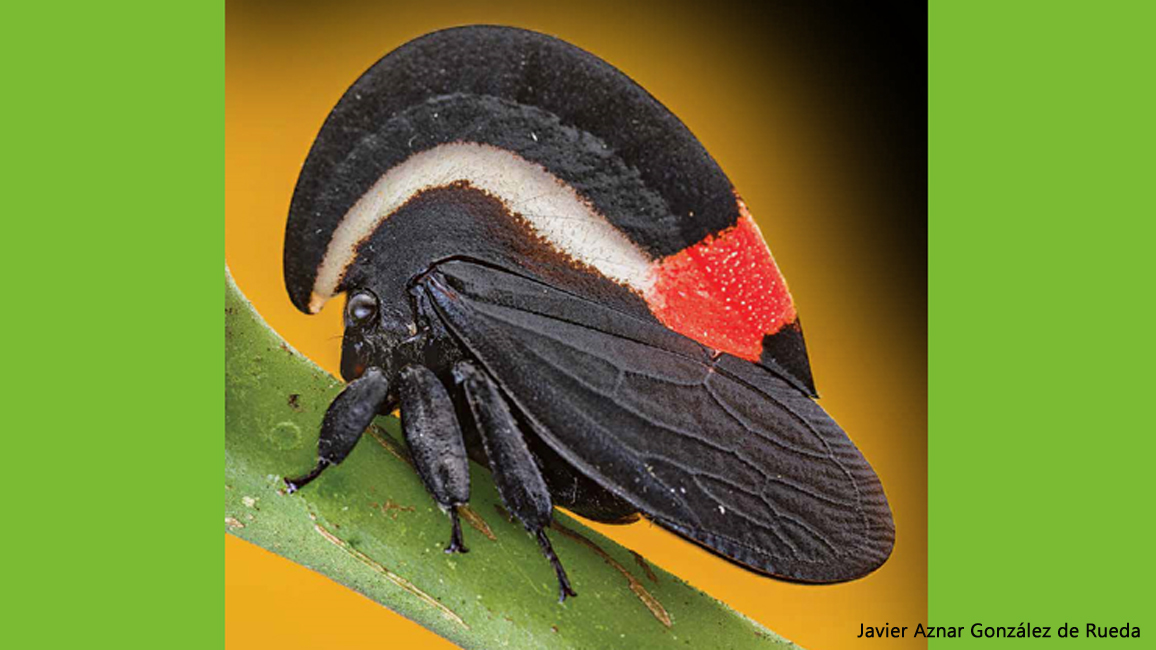
Treehoppers
By Gerry Bishop; photos by Javier Aznar González de RuedaHigh in treetops all around the world, billions and billions of tiny treehoppers are a-hoppin’. They’re some of the most extraordinary creatures on Earth. Yet many people don’t even know they exist.

As you can see from the small photo above of a person’s finger, treehoppers can be tiny! The world’s biggest kind of treehopper could sit on a nickel with room to spare. The smallest grows no bigger than a freckle! But treehoppers make up for their size with their super-strange shapes and surprising ways.
WILD HELMETS
On the top of every treehopper is a hard, tough “helmet.” The helmets come in many different shapes, sizes, and colors, depending on the species. They are amazing to look at, but scientists aren’t sure what they are for. Some hoppers have helmets that look like dried seeds, ragged leaves, or twisted branches. This might make it harder for hungry predators such as spiders or lizards to spot them. Some helmets are boldly colored, which may help attract mates or warn predators that the hoppers taste bad. And some have horns, knobs, or other weird shapes poking out. Could these keep predators from taking a bite? Maybe, but lots of treehoppers still end up as someone else’s dinner. So, for now, the only sure thing is that treehopper helmets are truly awesome!
Treehoppers are easily overlooked because they are so tiny. But close-up views show they have some remarkable features. The strange ball-like things on top of the Brazilian treehopper (above) can break off when a predator grabs them, letting the hopper escape.

BUGS FROM LONG AGO
Treehoppers have been around for about 100 million years. Today, they live on every continent except Antarctica. More than 3,400 species have been discovered so far, and scientists say there may be 10,000 more left to find. Here in the United States, there are at least 266 species. And you can bet that many of them hang out in treetops, shrubs, and grasses near you. But they’re so tiny, you’ll have to look hard to find them. You might have the best chance of spotting them on the twigs of oak trees in spring.
Treehoppers are close cousins to other insects you might know about: cicadas, aphids, and stinkbugs. All belong to a group called true bugs—insects that use their sharp, pointed beaks to stab into plants and suck out plant juice called sap.
BIG JOB SO LITTLE TIME
Adult treehoppers live for only a few months. And during that time, their main job is to make more treehoppers!
Sometimes, a male and female hopper just happen to meet up. But other times, finding a mate may start with a hopper vibrating its body against a twig. These vibrations travel along the twig, delivering a “Morse-code” message. And the message is, “Hey, want to get together?”
After mating, a female may cut a slit in a twig and lay her eggs inside it. Other kinds of hoppers may lay eggs right on top of a twig. Either way, the eggs soon hatch into tiny nymphs (NIMFS).
Some mother treehoppers carefully watch over their eggs and nymphs. Some even help their nymphs by making slits in twigs for them to feed from.
After about a month, the young treehoppers are all grown up and ready to find mates. More baby hoppers will soon be on the way!

HONEYDEW WE LOVE YOU!
It’s true that everybody poops, but not many creatures poop the way a treehopper does! While feeding on sap, hoppers pass drops of clear, sweet liquid called honeydew from their back ends. This honeydew is good food for ants, bees, and wasps. Even some little lizards lap it up.
To make sure they don’t lose their food supply, some ants, bees, or wasps will guard and care for the hoppers, their eggs, and their nymphs. Some ants will even build shelters around the hoppers.
ONE MORE SURPRISE ABOUT HOPPERS
Because they are called “treehoppers,” you might think these little insects hop from tree to tree all day. Not so. They spend most of their time sipping sap.
But sometimes a hopper just has to hop! When it needs to make a quick getaway from a predator, it tucks its powerful hind legs under itself, crouches down, and—BOING!—it shoots off into the air, far from danger.
This trick is great when it works. But sometimes a hopper gets caught anyway. No worries, though, for the wide world of treehoppers. There are always plenty more, hopping here, there, and just about everywhere.
VIDEO: WATCH GREEN WEAVER ANTS PROTECTING TREEHOPPERS!
Thanks to scientist Stuart McKamey of the USDA Systematic Entomology Laboratory in Beltsville, Maryland, for helping with this story.
















